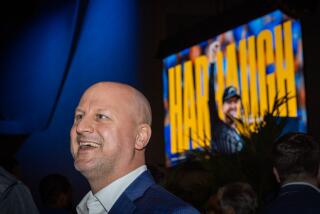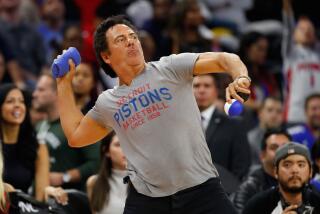Barron Hilton’s Chargers turned short stay into long-term success
- Share via
Fifty years ago this month, Nov. 22, 1959, to be exact, the Minnesota Vikings ran a reverse play that could have totally defeated the wannabe American Football League.
Yet somehow, the AFL survived, flourished and eventually merged with the big guy, the National Football League.
The man in the middle of all this, and greatly responsible for what the San Diego Chargers have become, is 82 years old now and is better known for hotels than football teams. But Barron Hilton, the retired chief executive of the Hilton Hotel Corp., says, “The happiest days of my life were the days I was involved with the Chargers.”
In the fall of 1959, the AFL was just getting its house in order. The established NFL was openly giggling at the attempts of this interloper but inwardly fearing the competition. The first step for the AFL would be to hold a draft and attempt to invade what was theretofore a monopoly held by the NFL.
Texas oilman Lamar Hunt had started the AFL. Among his owners were Bud Adams of the Houston Oilers and Ralph Wilson of the Buffalo Bills. Hunt asked a friend, former tennis star Gene Mako, whom he might seek for ownership in Los Angeles. Mako said Hilton, son of Hilton Hotel originator Conrad Hilton and a successful entrepreneur in his own right.
“I hadn’t met Hunt,” Barron Hilton says, “but when he came to see me and asked me if I wanted the Los Angeles franchise, I said yes.”
On the eve of the Nov. 22 AFL draft, amid rumors that the Minnesota franchise would defect to the NFL, Hilton called the franchise’s principal owner, Max Winter, and was assured he’d be staying in the AFL club. The next day, Minnesota joined the NFL, as an expansion team (soon to be christened the Vikings) to begin play in 1961, and many thought that would kill the new league.
But the draft went on, the AFL signed 75% of its draftees, and Hilton was soon exercising his influence again. He saw that many of his partners had geographic rivalries. In Los Angeles, he had none. So he pushed hard for the Minnesota franchise replacement to be a West Coast team, and the Oakland Raiders were born.
The AFL began play in 1960, and its wide-open style caught on quickly, although not everywhere. Hilton’s Chargers were sharing the Coliseum with the Rams, and an ever-skeptical L.A. treated these newcomers as it treats all newcomers.
“We were averaging 13,000-14,000 people,” Hilton says, “and that looked pretty ugly in the Coliseum.”
Sid Gillman was coach. Frank Leahy was the general manager, so far ahead of his time he had players’ names put on the backs of the uniforms. Al Davis was an assistant coach and Paul Lowe even ran back the first kickoff for a touchdown.
Hilton held a contest to name the team, and the winner was “Chargers.” He still fights the theory that he picked the name because he had a credit card company, Carte Blanche.
“It was after the trumpet call, followed by the roar of ‘Charge,’ ” he says. “It never had a thing to do with the credit card.”
He also had the lightning bolt on the helmet designed, being careful to avoid making it look like that of the Air Force Academy. “I have a passion for flying, and that’s why I wanted the bolt,” he says.
Hilton quickly realized that taking on the Rams in L.A. was like beating his head against the wall. Down the freeway, San Diego saw the dilemma, and the sports editor and columnist of its leading newspaper, the Union, led a public campaign that convinced Hilton he should move. He did in 1961, and the Chargers played in Balboa Stadium until 1967, when the team moved into a new stadium that the city paid for and eventually named after the sportswriter who had led the charge.
Jack Murphy Stadium stayed that way from 1980 until corporate interests trumped sentiment and it became Qualcomm in 1997.
By the time the Chargers had moved into their new stadium, the NFL had seen the financial foolishness of annual bidding wars for players and merged with the AFL. They cut the deal in 1966 and began playing as one big happy league in 1970.
“From the start,” Hilton says, “we had hoped at some point that we’d have a merger. But we also wanted a successful league, and we got that.”
Hilton owned the team for only six seasons -- “We won five Western Division titles and one AFL championship,” he says, proudly -- but when he sold to Gene Klein, he retained a part interest. He sold because the Hilton Corp. had asked him to take over the business, and to do so without spending time on football. His original investment had been $25,000 and the price Klein paid for controlling interest was $10 million.
Eventually, Hilton had to sell all of his interest in the team, partly because of his ownership of the Las Vegas Hilton and his role in creating the sports book there. The NFL, which thrives on the interest generated by fans’ betting on its games, has always battled any appearance of direct involvement with gambling interests.
Hilton sold another piece of the Chargers to current owner Alex Spanos in 1981. They agreed on the terms during a golf game at the Bel-Air Country Club.
“Between the eighth and ninth holes,” Hilton says.
Hilton, who manages his foundation out of an office located, fittingly, at the Beverly Hilton Hotel -- no longer owned by Hilton -- remains a big Chargers fan, going to most home games. He was honored during the coin toss Sept. 20 before they played Baltimore.
He remains much more loyal than the average fan.
“I hope Los Angeles gets a team,” he says, “but I sure hope it isn’t San Diego. They gave me a home in San Diego, and I’ll never forget them for it.”



